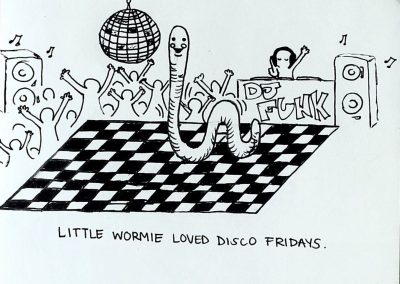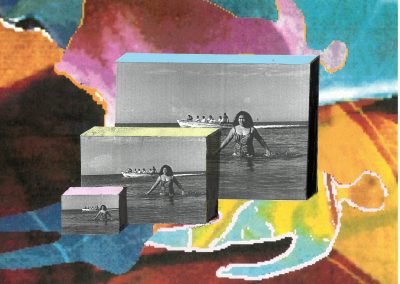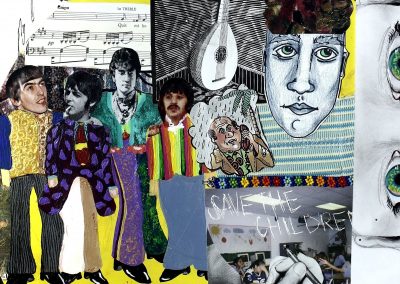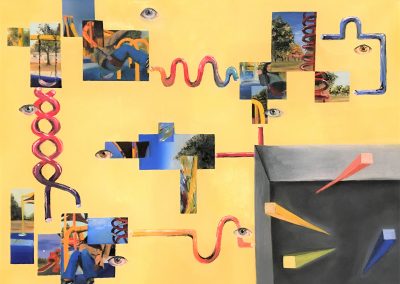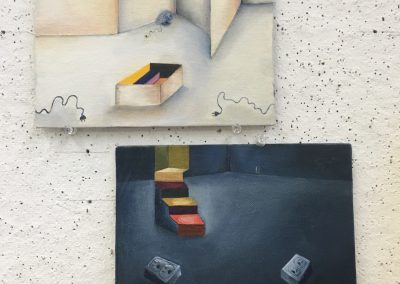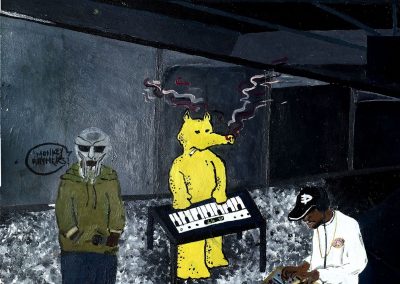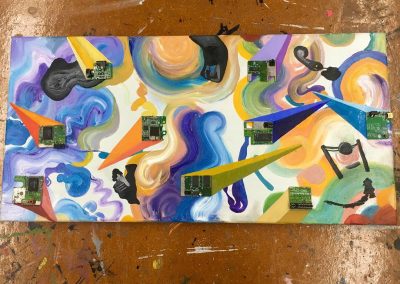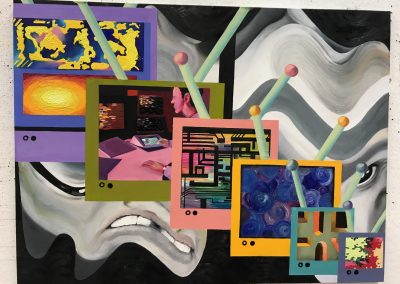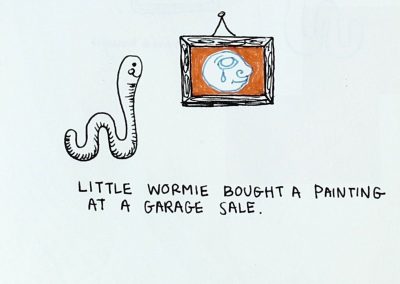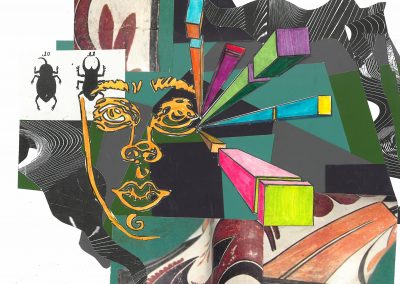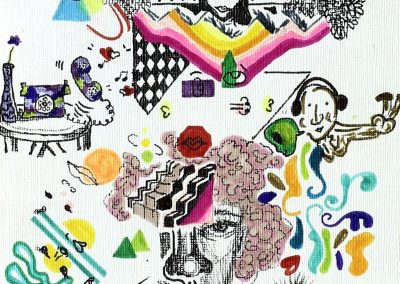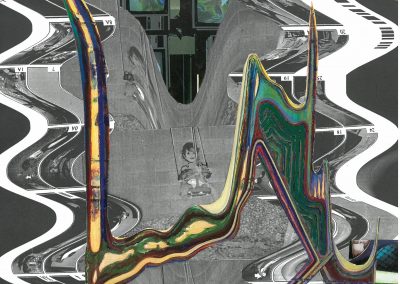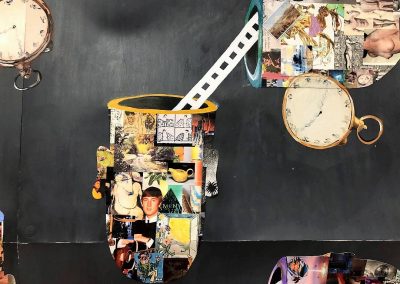Featured Artist
Gabriella Rodriguez is currently an undergraduate student at Whittier College working towards a major in Psychology and a minor in Art. Ever since she was a little girl, she loved making art and experimenting with art materials. As a growing individual, she has learned many things that has made her realize the potential her ideas have. In a world of little self-introspection, she hopes with her art she can express her own thoughts/feelings while provoking some from other people, hopefully making them more aware of their own experiences and their environment.
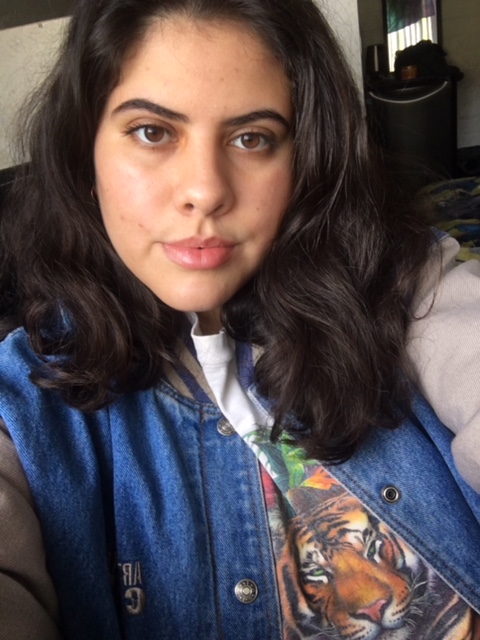
INTERVIEW
ANGLES: Can you tell us a little more about yourself?
GR: I’m pretty much just a regular person trying to live comfortable and see others happy. My biggest passion is creating art.
ANGLES: We were drawn to your use of collage throughout your body of work. Where do you start when you begin a collage?
GR: The process of making a collage is what really draws me into this type of art and construction. I love the idea that I can take something seen as useless or forgotten trash and turn it into art, with a new meaning and a new story. Not only for its recycling purposes but it mirrors what we do in everyday life. We go to school, we go to work, we ask questions and test theories our whole lives. Within these actions, we build off other people’s ideas and create patterns of meaning in our own lives. Making collages is the same thing. You take material from one place, add it somewhere else with other things and new ideas are born.
A lot of the collages I make are also very personal to me. I collect all the material used in my collages. Every picture or material used were found in thrift stores, garages sales, estate sales, swap-meets, random offices, libraries and a lot of the times just on the floor. It’s fun to pick random things with contrasting tones and different contexts and forcing them together on a page. Sometimes it makes the viewer confused and overwhelmed. But that’s the point. You have to question what you see, your reality has to be shaken up a bit to find out how solid it really is. I make these collages with themes and stories in my head, but I want whoever sees them to conceptualize their own ideas or feelings from it.
ANGLES: We loved the drawings of the worms! What inspired them?
GR: Little wormie is a character I created one summer out of boredom and is now one of my creations that means the most to me. After showing a friend of mine a little wormie drawing, he suggested I continue to do them and that’s where little wormie began to grow. Little wormie is a very special guy because he does ordinary things and finds so much happiness in them. That’s what makes him so different from everyone else. In other ways, little wormie goes through circumstances that every human faces. Wormie has gone through sadness, happiness, boredom, loneliness, and loss of hope. Little wormie is unique yet normal. Humble but grand. Little wormie is who I aspire to be.
ANGLES: The people featured throughout your work are illustrated in a variety of different ways. Do you have a certain way of approaching drawings of people?
GR: When I draw faces and certain people, there are basically no rules. I feel like manga and mainstream cartoons hold a very generic face for their characters. But the reality of it is is that there is no one face. No one perfect standard of beauty. There are people with big noses, asymmetrical face structures, small eyes, wrinkly chins, deep smile marks, hairy eyebrows, etc. I just want to include characteristics society does not consider beautiful, to normalize them. At the end of the day, we’re just made of different abstract shapes on our face and body, which is the approach I like to take when I draw people.
ANGLES: Do you see a theme emerging among the images that you’ve shared?
GR: At this stage of my life, I have realized I am made up of my childhood memories and experiences, many of which I don’t even remember. As a kid, I wanted my life to be different, I thought I knew it all and I thought growing up would be the best solution for whatever I was going through at the time. Looking back, although I have a lot more autonomy now, I would trade it all just to be a kid again. Not having a single worry, being able to get away with little things, being taken care of, not having to fake a role for anyone. The mental freedom I had then outweighs the physical freedom I have now. I now know I actually knew nothing, but that’s what I miss the most. Every day reality gets harsher and harder to deal with. In a lot of my paintings and drawings I try to be silly, loud, blunt and free-spirited like a child to deal with the realities. I don’t hide away from those realities but confront them and question them, much like a child would. I create dream-like states or busy pictures to parallel the life of a child, going by so quickly yet feels like an eternity. In other drawings and paintings, like Little wormie, I like to appreciate innocence and simple things children enjoy or look forward to (eg. a swing). I would say my child self and other things that represent that are included in my a lot of my works.
ANGLES: In your bio you talked a lot about how peoples’ perspectives of of the world are different, and, through art, you can share your views. Is there something larger you feel like your working towards in your art?
GR: As an inspiring psychologist, I am always thinking about the human mind and the human experience. From personal, second-hand and now educational experience, I’ve learned a healthy and genuine self-concept is crucial for a happy life. But for some reason in this world we put little importance into that. We don’t push kids to ask themselves who they are until they’re in college. And especially in today with social media’s popularity, the first self-concept these children develop is from what others are telling them what they are or should be. As I mentioned earlier, you don’t truly evaluate what means the most to you by receiving everything you desire or getting a clear messages. It is in confusion and doubt that you realize what scares you the most, because our fears represent us just as much as our desires. Once we face it, we can learn to deal with it. I hope that, in a smaller scale, I can create this confusion of thought with my work and make people question why things are set a certain way, why certain elements were including in the piece, etc. Just to get people to think a different way and in some way relate to the piece is enough to spark a more personal question, and therefore learning something new about themselves. Once we accept ourselves for who we are and learn to deal with our personal hardships, it is easier to find that same empathy for others.
ANGLES: It’s not always easy to share your work. What compelled you to begin sharing yours?
GR: I am the only artist in both my mom’s and dad’s families. This has made it difficult for me to be confident in what I’m presenting since there’s little interest shown. It has also made me question whether my creative side is really understood. But, aftering starting college and finding artist groups on different underground social medias, I realized there ARE people who care and are interested in art. It has opened me to a free world of weird, creative, offensive, uncomfortable, unimaginable art. Somehow their art traveled to me and not only interested me but inspired me too. I know that sharing my art can expose it to all different type of people and new minds. I am not afraid for people to be confused or uninterested, I just want people to look. Even if they never know I made it, my image will be stored somewhere in their brain and even in the most miniscule way alter their perception.
ANGLES: What are some challenges you’ve faced in working on these pieces?
GR: Something I struggle with is making my pieces too personal. It’s a struggle but it is also the reason why I love making things. I put a lot of thought and there’s always hidden context in my work, things that only I know. It’s hard to put all that time, effort,and history in these pieces and then try to give them away or display the, with no context. That’s why I have everything I’ve made, because it really feels like creating a child and not wanting to let it go because no one will love it like you do.
ANGLES: Final question–do you plan on continuing to create after graduation?
GR: I truly wish I could be a full time artist my whole life, but it’s unrealistic at this point in my life. The least I can do is create on my own free time. That’s what makes living worth it. It is the way I express myself, represent ideas too complex for words and free my mind. After graduation I hope to work as an art therapist and/or art teacher and change the way people view and incorporate art in their lives.
